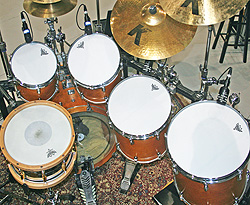Live instrument mic’ing is no picnic. Especially when there are multiple elements on a stage that an audio mixer wants to capture and reproduce properly.
With acoustic drums, the issue is compounded exponentially given that in order to isolate each drum “voice” correctly, you really need a heck of a lot of mics. Or do you?
There are a thousand ways to mic and mix a drum kit with success. Conversely, there a million ways to mix and mix a drum kit without success! So, given the potential complexity of this process, what are some ways to stave off a drum mic disaster?
Mic’ing drums should always start with a few questions. What is the musical style and sonic goal you are going for? It tends to break down into two basic approaches: “traditional” and “close mic’ed.”
Are you seeking a naturally balanced, traditional drum kit sound or a close-miked drum kit sound? The former employs one or more overhead mics plus a kick drum mic and is a more purist approach, common in styles such as classic jazz. The latter requires a close-up mic on each drum in the kit plus a hi-hat mic and one or more overhead mics and is typical of modern pop and rock styles.
Traditional Approach
This approach is aimed at maintaining the acoustic balance of the drum kit as produced by the drummer. The main key is mic placement. When properly executed, it largely avoids audible phasing (destructive comb filtering) problems.
Detailed measurements are often used for exact mic placements. Seriously, techs sometimes use a tape measure to make certain the snare drum is equidistant from multiple overhead condensers. Comb filtering, here, is a degradation of the sound quality that happens when multiple mics are mixed together with slight timing offsets due to placement.
This drum mic’ing style yields less gain-before-feedback in sound reinforcement situations and is most prone to leakage if there are loud adjacent sound sources. It also requires excellent musical balance by the drummer and offers very little balance control to the audio mixer, whether good or bad.
In addition to the overhead mic(s), a kick drum mic may be added for extension. Only two or three audio channels are required.
Close-Mic’ed Approach
This approach uses a microphone focused on each drum, plus a hi-hat mic and one or more overhead mics. The style offers increased gain-before-feedback and exceptional balance control to the sound mixer, but largely ignores the natural balance of the drum kit.
As the sound mixer has far more control, he/she assumes the responsibility for correct kit balance. Upwards of a dozen or more audio channels are required.
Comb filtering is an often present and accepted (or overlooked) compromise in the close mic’ed approach. This sonic degradation can sneak up! When putting several mics in a kit, inter-leakage is also a real concern.
So, where we point the nulls of our mics may be as important, or even more important, than where we point the front of them! Nulls are the least sensitive sides of the microphones.
Note that it is common to have some combing between the spot mics and the overhead mic(s). This is because the snare, for example, is picked up almost immediately by its spot mic but is also heard in the overhead(s) with a bit of delay—just several milliseconds. This is a compromise that may be accepted. It is treatable in some digital console applications by using channel delay to “line up” such spot mics with the slightly delayed overhead leakage.
Such alignment is audible as a clearer sound. But, often mixers must live with the influences of comb filtering as a trade-off to the close miked technique and just mix around it. There is still no tool as important as the human ear!





















